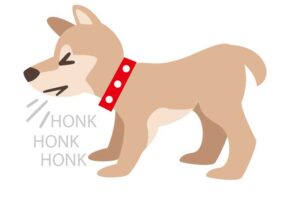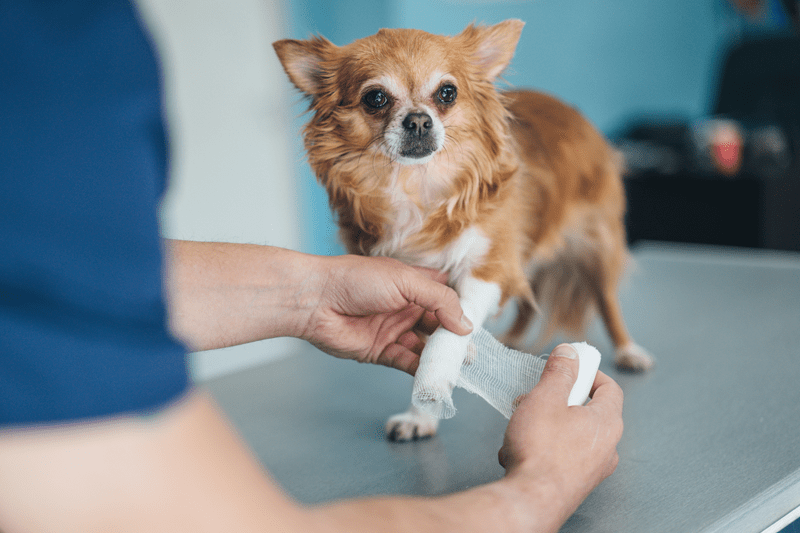Their portable size, moderate energy levels, and adaptable personality make small-breed dogs the most popular dogs in the United States. From the urban jungle, to the dog park, to the runway, little paws have left a permanent impression in our hearts.
Unfortunately, the diverse group of little dogs comes with unique health problems. Here are the top five most common small-dog injuries and conditions we see at UrgentVet.
#1: Intervertebral disc disease and small dogs
Many small-dog owners enjoy the portability advantage. One person can easily lift, carry, or transport a small- and toy-breed dog—and they are especially cute riding along in a bag or purse.
Unfortunately, as dogs were bred to be smaller, their legs were made shorter and their backs longer. This creates more pressure in the middle of the back, and less stability. Just like a “slipped disk” in humans, the cartilage in these areas becomes weak and may move abnormally. Sudden movements such as jumping off furniture, leaping off stairs, or slipping from someone’s arms can lead to a greater impact force. This can force intervertebral disk material into the spinal cord, and result in pain and even paralysis.
Intervertebral disc disease (IVDD) is a progressive condition that can cause pain, weakness, and partial or complete paralysis. Signs may be gradual or sudden, and include:
Reluctance to jump or use stairs
Low head or body posture
Hunched back
Limping
Reduced activity, loss of interest in play

The following signs indicate spinal cord compression (i.e., disc herniation) and require emergency veterinary attention:
Crying out in pain (often a sudden yelp even if not touching the pet)
Stumbling or uncoordinated gait
Knuckling or foot dragging (especially the rear legs)
Paralysis
Difficulty urinating or not being able to hold urine
Paralyzed dogs often need emergency surgery (usually within 12-24 hours) to restore the dog’s mobility. This surgery is performed by a surgeon in a specialty hospital. In some instances, dogs can improve with prolonged strict cage rest and medication. Because IVDD is a chronic condition, small dogs must be closely monitored for recurrence, and provided with at-home modifications, such as ramps and pet stairs.
#2: Luxating patellas in small dogs
The dog’s patella (i.e., knee cap) is a small bone contained inside a ligament that rides along a groove in the femur (i.e., the thigh bone). When the dog bends and straightens their knee, the patella should stay in the groove, to ensure stability and smooth movement.
However, in many small breed dogs, this groove is shallow or misshapen, which allows the patella to luxate (i.e., slide out of place), making the joint unstable and leading to complications that may include cruciate ligament rupture. Many small dogs with a low-grade luxation can live normally, but surgery to deepen the groove is recommended for severe cases.

Many veterinarians routinely evaluate small-dog patellas as part of their annual examination. However, you may notice some signs at home, including:
Reluctance to jump or climb stairs
Holding up a rear leg while running or trotting
Kicking or jerking one back leg to self-reduce a luxated patella
#3: Collapsing trachea in small dogs
The dog’s trachea (i.e., windpipe) is made of flexible soft tissue and C-shaped cartilage rings that provide structure and support to ensure an unobstructed air exchange to and from the lungs. Small dogs may have weak rings because of a congenital condition and may struggle to breathe if the trachea collapses and impedes air flow.

Signs in small dogs with collapsing trachea include:
Coughing, especially when pressure is applied to the neck or chest (e.g., pulling on leash)
Gagging or retching
Vomiting
Blue gums or tongue (i.e., cyanosis)
Respiratory distress
For many small dogs, collapsing trachea can be managed with medication, weight management, environmental modification (i.e., avoiding overexcitement, hot weather, air pollution) and wearing a body harness rather than a collar. Surgical correction, which involves placing a stent to open the trachea, is often recommended for dogs with significant respiratory distress.
#4: Mitral valve disease in small dogs
Degenerative mitral valve disease (i.e., leaky valve disease) is a form of heart disease common in small-breed dogs. The disease occurs when the heart valves do not open and close properly and blood is leaked backward when the heart contracts. This reduces the heart’s efficiency, leading to heart enlargement, and further reducing contraction strength. Severely affected dogs may experience congestive heart failure.
Because a distinctive murmur is often the first sign in mitral valve disease, the condition is often diagnosed as part of a routine wellness exam. Imaging (e.g., X-ray or echocardiogram) and a blood test may be recommended to screen for heart enlargement or disease. Most small dogs respond well to medication and monitoring, but dogs with congestive heart failure require more intensive care.

#5: Brachycephalic obstructive airway syndrome in small dogs
Brachycephalic (i.e., flat-faced) dogs are some of the most beloved breeds, but their pushed-in facial appearance causes many respiratory abnormalities—collectively referred to as brachycephalic obstructive airway syndrome (BOAS). These abnormalities include a narrow trachea, small nostrils, and an elongated soft palate. As normal air flow is challenged or compromised, BOAS dogs may snort, snore, hyperventilate, suffocate, or experience significant respiratory distress.
Brachycephalic dogs should be protected from stressful situations, including heat, humidity, and overexcitement, monitored closely for weight, since obesity compounds BOAS, and assessed for surgical correction.

Compact canines bring joy to millions of Americans every day—however, these diminutive dogs may be easier to manage, but their unique care needs require an extra-attentive owner. If your small dog is experiencing a non-life threatening medical problem—large or small—contact an UrgentVet location near you—because your pet can’t wait to feel better.


